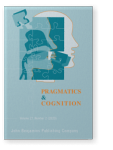Vol. 27:2 (2020) ► pp.313–338
The role of non-connective discourse cues and their interaction with connectives
The disambiguation and processing of coherence relations is often investigated with a focus on explicit connectives, such as but or so. Other, non-connective cues from the context also facilitate discourse inferences, although their precise disambiguating role and interaction with connectives have been largely overlooked in the psycholinguistic literature so far. This study reports on two crowdsourcing experiments that test the role of contextual cues (parallelism, antonyms, resultative verbs) in the disambiguation of contrast and consequence relations. We compare the effect of contextual cues in conceptually different relations, and with connectives that differ in their semantic precision. Using offline tasks, our results show that contextual cues significantly help disambiguating contrast and consequence relations in the absence of connectives. However, when connectives are present in the context, the effect of cues only holds if the connective is acceptable in the target relation. Overall, our study suggests that cues are decisive on their own, but only secondary in the presence of connectives. These results call for further investigation of the complex interplay between connective types, contextual cues, relation types and other linguistic and cognitive factors.
Article outline
- 1.Introduction
- 2.Processing coherence relations and their cues
- 2.1Coherence relations
- 2.2Discourse connectives
- 2.3Other cues
- 2.4Predictions
- 3.Experiments
- 3.1Norming study: Continuation selection task
- 3.1.1Materials and procedure
- 3.1.2Participants
- 3.1.3Results
- 3.1.4Discussion
- 3.2Experiment 1: Connective insertion task
- 3.2.1Materials and procedure
- 3.2.2Participants
- 3.2.3Results
- 3.2.4Discussion
- 3.3Experiment 2: Forced choice task
- 3.3.1Materials and procedures
- 3.3.2Participants
- 3.3.3Results
- 3.3.4Discussion
- 3.1Norming study: Continuation selection task
- 4.General discussion
- 5.Conclusion
- Notes
-
References
For any use beyond this license, please contact the publisher at [email protected].
